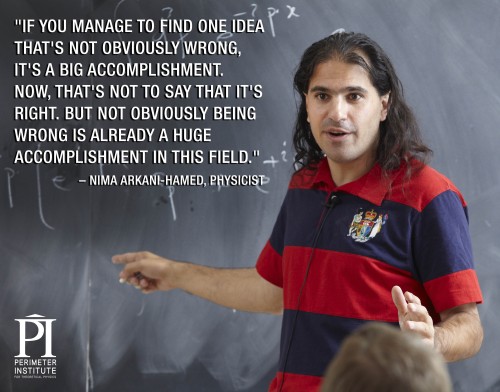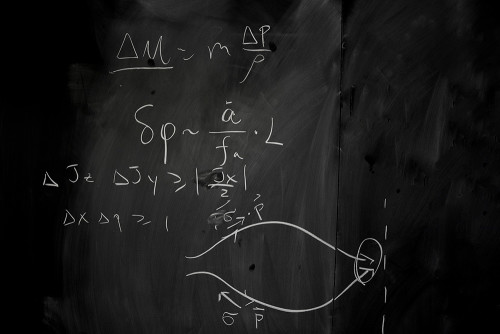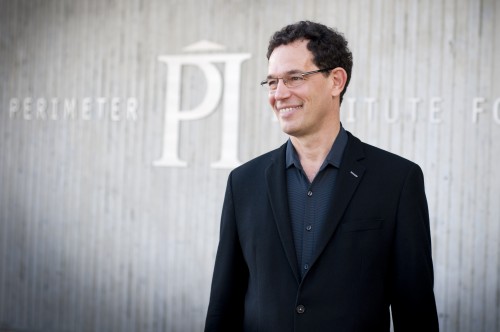Tag archives: Perimeter Institute
Test your brains with the Physics World blackboard quiz
By Matin Durrani
Can you tell what branch of physics is being described on the blackboard above? It’s one of six photographs taken by the communications folks at the Perimeter Institute for Theoretical Physics in Waterloo, Canada, where blackboards are an integral feature of the building’s design, appearing everywhere from the lifts to coffee areas.
In this quiz, your task is to study six blackboards and match them up with the physics topics they represent. There’s no prize, other than the satisfaction of having at least some inkling of what those clever theorists at the Perimeter are up to.
So here are the six topics:
• Accretion physics and general relativity
• Cosmology
• Neural networks and condensed matter
• Particle physics 1
• Particle physics 2
• Strings
And here are the six blackboards (you can click on each to see it in more detail).
Perimeter Institute discuss LIGO findings
By Michael Banks
Following the exciting news that the US-based Advanced Laser Interferometer Gravitational-Wave Observatory has discovered gravitational waves, the folks at the Perimeter Institute for Theoretical Physics in Canada are hosting a live webcast panel discussion at 13:00 EST (18:00 GMT) today.
And the winner is: our 2015 Nobel-prize predictions

Psychic world: we have another go at predicting the Nobel winners. (Courtesy: iStockphoto/shutter_m)
By Tushna Commissariat and Hamish Johnston
Update: Looks like we were quite spectacularly wrong this time around with our predictions as this year’s Nobel has been awarded to Arthur McDonald and Takaaki Kajita “for the discovery of neutrino oscillations, which shows that neutrinos have mass”. While Physics World’s news editor Michael Banks did predict this in 2013, we did not think this would be the year. Clearly, as our “Which physics disciplines attract the most Nobel prizes” infographic suggests, the field of particle physics still seems to be the most Nobel-worthy one.
It’s a mug’s game, we know, but come the start of October we just can’t resist trying to predict who will win the Nobel Prize for Physics, which this year will be announced on Tuesday 6 October.
With the exception of 2013 – when most pundits were right in thinking that the prize would be related to the 2012 discovery of the Higgs boson – predicting the next Nobel winners (or winners) is a tough call. If you want to take an analytical approach, check out the infographic we published last year: “Which physics disciplines attract the most Nobel prizes”. It suggests that the field of atomic, molecular and optical physics is due a prize, and one of us (Hamish Johnston) thinks an excellent bet is Deborah Jin for her work on fermionic condensates. If Jin were to win, she would be only the third woman ever to win a physics Nobel – the other two being Marie Curie in 1903 and Maria Goeppert-Mayer in 1963.
Agreeing to disagree at the next Convergence conference

The closing panel. From left to right: Patrick Brady, Stefania Gori, Immanuel Bloch, Sara Seager and Ian O’Neill.
By Hamish Johnston
I have just returned from the Perimeter Institute (PI) in Waterloo, Canada where I enjoyed a fantastic few days immersed in discussions involving some of the sharpest minds in physics. The great and good were at the PI for the first Convergence conference and from what I have heard, the participants are calling it a great success.
But could it be even better next time?
First image of a black hole expected a year from now
By Louise Mayor in Waterloo, Canada
According to Avery Broderick, a physicist at the University of Waterloo and the Perimeter Institute for Theoretical Physics (PI) in Canada, the iconic picture of a black hole from the film Interstellar “really only presages astronomical reality by about a year”. That’s because, as Broderick explains, “as soon as next spring the Event Horizon Telescope is gonna produce images of the black hole at the centre of the Milky Way”.
Why converge?
By Louise Mayor in Waterloo, Canada
Right now, top physicists from around the world are arriving in Waterloo, Canada, to attend a unique conference. Christened Convergence, the meeting is the brainchild of Neil Turok, director of the Perimeter Institute for Theoretical Physics (PI) in Waterloo, where the event will be based. I spoke to Turok to find out what motivated him to set up this conference, what makes it so special, and what he hopes it will achieve.
Heavy-metal Higgs, meet the Publons, Stephen Hawking’s galactic tour and more
By Tushna Commissariat and Hamish Johnston
I’m sure that most of you have wondered what the Higgs boson would sound like if it were a heavy-metal song. Now you can turn it up to 11 (TeV that is) courtesy of CERN physicist and guitarist Piotr Traczyk, who has “sonified” data from two plots from the CMS experiment that were presented at the Higgs discovery seminar on 4 July 2012. His heavy-metal ditty is based on gamma–gamma and 4-lepton data from CMS and after you listen to his excellent song in the above video, you can find out more about how it was created by reading this entry by Traczyk on the Cylindrical Onion blog.
View all posts by this author | View this author's profile
A 21st-century discourse on quantum mechanics and space–time

Revealing the secrets of space–time? (Courtesy: Perimeter Institute for Theoretical Physics)
By Tushna Commissariat
If you fancy a bit of late-night quantum mechanics, make sure that tonight you tune into the live webcast of “Quantum Mechanics and Spacetime in the 21st Century” – a lecture that by physicist Nima Arkani-Hamed as part of the Perimeter Institute’s Public Lecture Series. Arkani-Hamed, who won the inaugural Fundamental Physics Prize in 2012, says that he hasn’t “been this excited about physics in a very long time”. He will talk about how the most recent advances in quantum mechanics shed new light on our understanding of the universe’s fabric of time and space. In the past, Arkani-Hamed has shown how the weakness of gravity, compared with the other fundamental forces of nature, might be explained by the existence of extra dimensions of space. He has also recently been involved in the 2013 documentary Particle Fever, about the search for the Higgs boson.
The webcast will begin at 11.45 p.m. GMT (7 p.m. EST) and you can send questions to Arkani-Hamed by tweeting @Perimeter and using the hashtag #piLIVE. Take a look at a short teaser video for his talk below and tell us what you think about it in the comments section.


